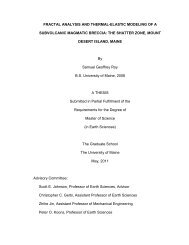Jumars, P.A. - University of Maine
Jumars, P.A. - University of Maine
Jumars, P.A. - University of Maine
You also want an ePaper? Increase the reach of your titles
YUMPU automatically turns print PDFs into web optimized ePapers that Google loves.
NEW SPECIES OF NORTH PACIFIC DORVILLEID POLYCHAETES 123<br />
markedly different in shape . Only one pair <strong>of</strong> carriers and two rows <strong>of</strong> denticles<br />
are present, the carriers being fused with basal plates .<br />
Remarks. Exallopus is monotypic and is named for the "very different foot"<br />
it bears in front <strong>of</strong> all the others . The setae and maxillae clearly fall outside the<br />
range <strong>of</strong> variation for any other genus <strong>of</strong> Dorvilleidae .<br />
Exallopus cropion sp . nov .<br />
(Fig . 11)<br />
Material' examined . Two specimens from SIO J14 (AHF Poly . 1077-8) were<br />
examined . The holotype remains in alcohol, while the paratype was mounted<br />
whole after being cleared in xylol .<br />
Description . The holotype is an ovigerous female in two pieces . It is 5 .1 mm<br />
long and 0 .21 mm wide and has 47 setigers . The pygidium and an unknown<br />
number <strong>of</strong> posterior setigers are missing . The rounded prostomium (Fig . 1 1A)<br />
bears two digitiform antennae arising at the posterior ends <strong>of</strong> a pair <strong>of</strong> shallow,<br />
longitudinal grooves . A constriction near the base may indicate the antennae<br />
are biarticulate . The palps each consist <strong>of</strong> a globose basal article with a digitate<br />
palpostyle . Parapodia (Fig . 1 1B) lack dorsal cirri . A ventral cirrus is absent on<br />
the first parapodium, weakly developed on the second ; and fully formed and<br />
obovate on the third . Above the acicula <strong>of</strong> the first parapodium are a pair <strong>of</strong><br />
slightly recurved, apparently smooth spines (Fig . 11E) . Below are about four<br />
strongly curved, extremely thick, smooth falcigers (Fig . 11F) . The shaft is bent<br />
in the opposite direction from the appendage, giving an overall recurved<br />
appearance . In the second and subsequent parapodia, these setae are replaced<br />
by denticulate capillaries (Fig . 11C) and spinigers with distally rounded but<br />
denticulate shafts and smooth appendages (Fig . 1 1D) .<br />
The mandibles (Fig . 11H) are anteriorly flared both laterally and dorsoventrally<br />
in a trumpet shape . but denticulation is not apparent . The maxillae<br />
(Fig. 11G) contain only two rows <strong>of</strong> denticles, their basal plates fused<br />
posteriorly and also fused with the carriers .<br />
The gut in both specimens is empty .<br />
Remarks. The shape <strong>of</strong> the falcigers in the first setiger suggests a holding<br />
function . E. cropion may thus be commensal with some other species in the<br />
sample . It is named for the scythe-like appearance <strong>of</strong> these modified falcigers .<br />
Distribution . The species is known only from the Coronado Sea Fan region<br />
<strong>of</strong> the San Diego Trough in silty mud at a depth <strong>of</strong> 1224 m .<br />
Genus Ophryotrocha Claparede & Mecznikow, 1869<br />
Type-species . Ophryotrocha puerilis Claparede & Mecznikow, 1869 .<br />
Diagnosis . The prostomium is roughly hemispherical . Antennae and palps are<br />
reduced to papilliform appendages . Dorsal cirri lack notoaciculae and may be<br />
absent altogether . Only two classes <strong>of</strong> setae are found in each species :<br />
(1) capillary and (2) compound heterogomph . Carriers and all four basal plates<br />
are fused in a characteristic ice-tong shape . Denticles <strong>of</strong> the inferior rows may<br />
be partly or completely fused with denticles <strong>of</strong> the superior rows, producing<br />
either four or two apparent rows <strong>of</strong> denticles .
















